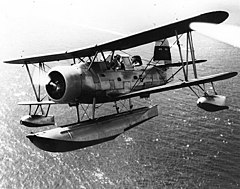Curtiss SOC Seagull
 Curtiss SOC-1 Seagull należący do US Navy w locie, 2 lipca 1939 | |
| Dane podstawowe | |
| Państwo | |
|---|---|
| Producent | Curtiss-Wright |
| Typ | |
| Konstrukcja | mieszana |
| Załoga | 2 |
| Historia | |
| Data oblotu | kwiecień 1934 |
| Lata produkcji | 1934–1938 |
| Wycofanie ze służby | 1945 |
| Liczba egzemplarzy | 322 |
| Dane techniczne | |
| Napęd | 1 × Pratt-Whittney R-1340 Wasp |
| Moc | 550 KM (410 kW) |
| Wymiary | |
| Rozpiętość | 10,98 m |
| Długość | 9,58 m |
| Wysokość | 4,5 m |
| Powierzchnia nośna | 31,77 m² |
| Masa | |
| Własna | 1716 kg |
| Osiągi | |
| Prędkość maks. | 266 km/h |
| Prędkość przelotowa | 214 km/h |
| Prędkość minimalna | 90 km/h |
| Prędkość wznoszenia | 4,64 m/s |
| Pułap | 4540 m |
| Zasięg | 1086 km |
| Dane operacyjne | |
| Uzbrojenie | |
| 2 karabiny maszynowe Colt-Browning kal. 7,62 mm 295 kg bomb | |
| Użytkownicy | |
| Stany Zjednoczone | |
| Rzuty | |
 | |
Curtiss SOC Seagull (ang. mewa) – jednosilnikowy, dwupłatowy, wodnosamolot rozpoznawczy (SO – "scout-observation" – zwiadowczo-obserwacyjny) używany przez US Navy w czasie II wojny światowej.
Służył jako samolot pokładowy na pancernikach i krążownikach, w powietrze był wyrzucany z rampy-katapulty. Skrzydła samolotu składały się do tyłu w celu zmniejszenia powierzchni składowania. Napęd stanowił silnik gwiazdowy Pratt & Whitney R-1340, górne skrzydła zostały wyposażone z klapy i sloty, co dało samolotowi znakomitą charakterystykę lotu przy małych prędkościach – było to niezmiernie ważne dla samolotu wyrzucanego z katapulty i lądującego na wodzie.
Samolot został zamówiony w 1933 i oblatany już rok później, do służby wszedł z 1935 zastępując wszystkie poprzednie dwupłatowce. Produkcję zakończono w 1938 i planowano go zastąpić w 1940 nową, jednopłatową konstrukcją, jednak mający go zastąpić Curtiss SO3C okazał się samolotem bardzo nieudanym. Na większości pancerników, gdzie samoloty były zazwyczaj przechowywane na pokładzie, został zastąpiony przez samolot Vought OS2U Kingfisher, ale jako samolot obserwacyjny krążowników służył prawie do końca wojny.
Linki zewnętrzne
- Zdjęcia samolotu. [dostęp 2009-07-27].
- Rysunki samolotu. [dostęp 2009-07-27].


Media użyte na tej stronie
US Flag with 48 stars. In use for 47 years from July 4, 1912, to July 3, 1959.
Roundel used by the United States armed forces from 19 August 1919 to 6 May 1942 until red dot removed to avoid confusion with Japanese insignia. Superseded very similar roundel whose colors and proportions differed slightly - the original version having the colors from the US flag, and a center dot 1/3 of the outer radius. This version has a center dot constrained by the inner vertices of the star, a size that does not translate into an even fraction.
Roundel used by US armed forces from 6 May 1942 to 28 June 1943 when white bars and a red outline were added as the result of studies which showed that shape was more important than color from a distance.
Autor: NiD.29, Licencja: CC-BY-SA-3.0
Roundel used by all US armed forces from 31 July 1943 to 14 January 1947, replacing roundel having red outline, or no outline, but with white bars, and was replaced some nine months before the USAF was formed, by roundel having a single lengthwise red bar inset in white bars (bisecting them), giving the insignia the trio of red-white-red stripes evocative of the non-canton areas of the Flag of the United States.
Line drawings for the U.S. Navy Curtiss SOC Seagull. Normally a floatplane, the SOC could also be fitted with a conventional undercarriage.
A U.S. Navy Curtiss SOC-1 Seagull scout-observation aircraft (BuNo 9979) in flight, 2 July 1939.
A U.S. Navy Curtiss SOC-3A Seagull of Scouting Squadron 201 (VS-201) parked on the flight deck of the escort carrier USS Long Island (AVG-1) on 16 December 1941. Note the depth bomb carried below the plane's fuselage, and the practice bomb rack below the left wing.
The U.S. Navy heavy cruiser USS Tuscaloosa (CA-37) hoists in a Curtiss SOC Seagull scout-observation plane after a patrol while on a convoy to Iceland.
U.S. Navy Lieutenant Commander Lex L. Black, commanding officer of Auxiliars Scouting Squadron 1 (VGS-1), makes the 2000th landing on the escort carrier USS Long Island (AVG-1), 20 April 1942. He was flying a Curtiss SOC-3A Seagull. Note the lowered flaps and the deployed leading edge slats on the upper wing.












